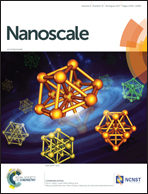Encapsidated ultrasmall nanolipospheres as novel nanocarriers for highly hydrophobic anticancer drugs†
Abstract
The design and construction of novel nanocarriers that have controlled shape and size and are made of inherently biocompatible components represents a milestone in the field of nanomedicine. Here, we show the tailoring of nanoliposphere-like particles for use as biocompatible drug nanocarriers. They are made with the building block components present in human lipoproteins by means of microfluidization, which allows for good size and polydispersity control, mimicking the physical properties of natural low-density lipoproteins (LDLs). This new type of nanocarrier has a negative surface charge and a hydrophobic core that allow the stabilization and encapsulation of hydrophobic anticancer drugs such as camptothecin, resulting in anticancer drug-loaded nanolipospheres. However, we found that the nanoparticles are unstable since their size increases with time. These nanolipospheres were further encapsidated using the non-cytotoxic capsid protein of the plant virus CCMV, which renders the nanoparticles stable. In a more general application, this new virus-like particle confers a controlled microenvironment for the transport of any kind of hydrophobic drug that can bypass the cellular defense mechanisms and deliver its payload.



 Please wait while we load your content...
Please wait while we load your content...